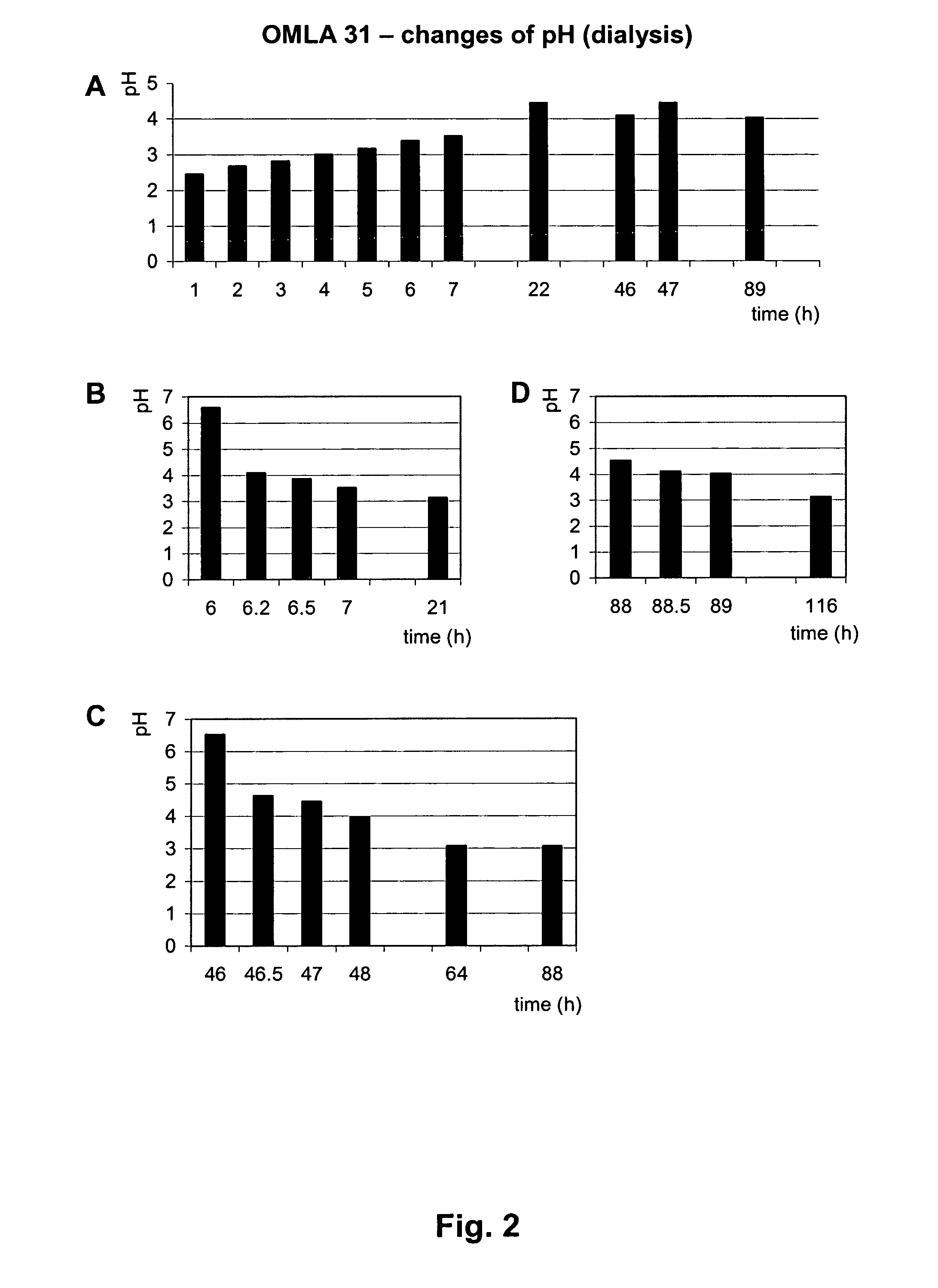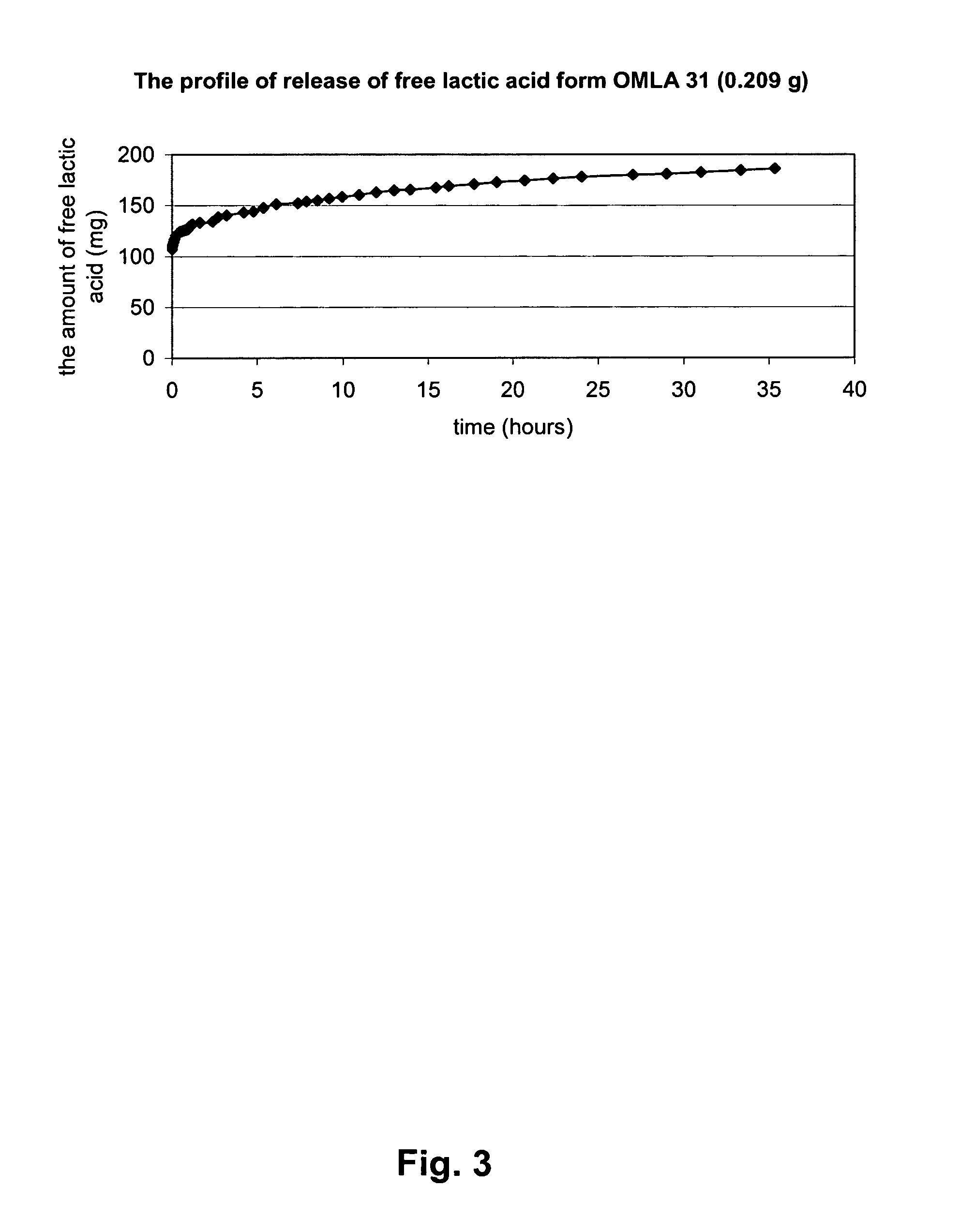Use of oligomers of lactic acid in the treatment of gynaecological disorders
a technology of lactic acid and gynaecological disorders, which is applied in the direction of anti-infective drugs, drug compositions, medical preparations, etc., can solve the problems of poor perinatal outcome, imbalance of normal vaginal flora, and complicated management of recurrent infections
- Summary
- Abstract
- Description
- Claims
- Application Information
AI Technical Summary
Benefits of technology
Problems solved by technology
Method used
Image
Examples
example 1
Preparation of an Oligomer of Lactic Acid
[0223]Oligomers of lactic acid (OMLA) were produced by heating a commercial quality of lactic acid (LA), containing 85% LA and 15% water, at 120° C. in open tubes for different times, thus oligomerising LA to various degrees and producing products with varying viscosity. The number of the OMLA product (e.g. OMLA 12) indicates for how many hours it was heated.
[0224]The various oligomers were characterised as described in Example 9.
example 2
In Vitro Release of Lactic Acid from OMLA 12
[0225]This experiment demonstrates the efficiency of OMLA as a source of acidic components and for retaining low pH for a prolonged time.
[0226]Release of acidity from OMLA (OMLA 12, formed after 12 hours at 120° C.). OMLA 12, 1 g, was placed in a dialysis bag which was placed in distilled water, 50 ml, at room temperature. The water was stirred continuously with a magnet stirrer. The pH of the water was measured at regular intervals, after replacing the liquid as well as during the intervals between exchanges. After 3, 7 and 47 hours the water was exchanged with fresh water. The results are shown in FIG. 1, where the graphs demonstrate the changes of pH measured in water outside the dialysis bag. FIG. 1A represents the pH value 1 h after replacing the liquid, and FIG. 1B-1D show pH change through the periods between the exchanges of water outside of the dialysis bag. It is evident that OMLA produces acid for many hours (days) during the ex...
example 3
In Vitro Release of Lactic Acid from OMLA 31
[0228]This experiment demonstrates the efficiency of OMLA as a source of acidic components and for retaining low pH for a prolonged time and allows for comparison whether the effect can be related to the molecular weight of OMLA.
[0229]An experiment identical to Example 2 was conducted with OMLA 31 (formed after 31 hours at 120° C.), although the water outside of the dialysis sac was exchanged more frequently (every hour up 7 h, and later after 21, 45 and 88 h). Results are shown in FIG. 2. FIG. 2A represents the pH value 1 h after replacing the liquid, and FIG. 2B-2D show pH change through the periods between the exchanges of water outside of the dialysis bag.
[0230]The conclusions are the same as given in Example 2. Moreover, it is demonstrated that depending on the molecular weight of OMLA the reduction of pH may be larger or smaller: pH between 3 and 4.5 was easier to maintain when OMLA 31 was used, while with OMLA 12 the pH was below 3....
PUM
| Property | Measurement | Unit |
|---|---|---|
| pH | aaaaa | aaaaa |
| polydispersity index | aaaaa | aaaaa |
| polydispersity | aaaaa | aaaaa |
Abstract
Description
Claims
Application Information
 Login to View More
Login to View More - R&D
- Intellectual Property
- Life Sciences
- Materials
- Tech Scout
- Unparalleled Data Quality
- Higher Quality Content
- 60% Fewer Hallucinations
Browse by: Latest US Patents, China's latest patents, Technical Efficacy Thesaurus, Application Domain, Technology Topic, Popular Technical Reports.
© 2025 PatSnap. All rights reserved.Legal|Privacy policy|Modern Slavery Act Transparency Statement|Sitemap|About US| Contact US: help@patsnap.com



